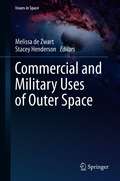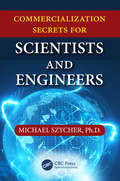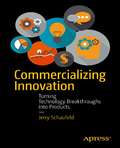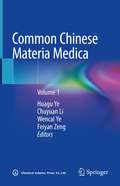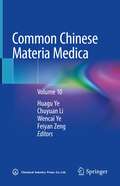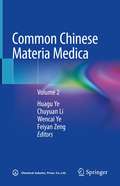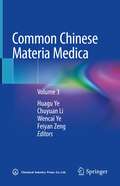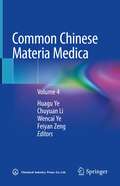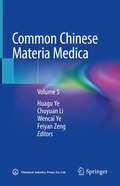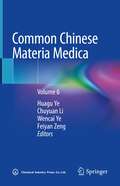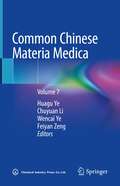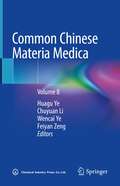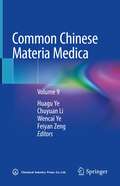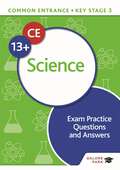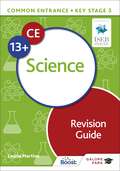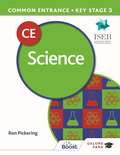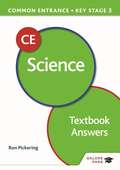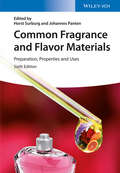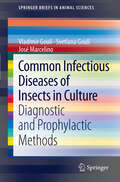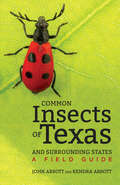- Table View
- List View
Commercial and Military Uses of Outer Space (Issues in Space)
by Melissa De Zwart Stacey HendersonThis edited book brings together a diverse range of chapters on space related topics. The authors included in this book are drawn from Australia and overseas, from academia, government, industry, civil society and the military. This book contains chapters that cover topics such as law, science, archaeology, defence, policy, and more, all with a focus on space. This edited collection is a timely international and interdisciplinary book, which addresses some of the contemporary issues facing activities in space and those attempting to understand, use and regulate the space domain. This edited book seeks to normalise the role of women as experts in the space sector, by not calling attention to the fact that all the authors are women – they are all experts in their respective fields who just happen to be women. Bringing together these contributions in this book in turn promotes the inclusion of diversity in the space sector. This edited collection is an opportunity to influence the development of the space industry – in terms of gender diversity, and diversity of disciplines and thinking – while it is in its formative stage, rather than trying to redress imbalances once they are entrenched in the industry.
Commercialization Secrets for Scientists and Engineers
by Michael SzycherCommercializing a knowledge-based product or service requires a realistic, methodical approach combined with a great deal of perseverance. Commercialization Secrets for Scientists and Engineers serves as a high-level guide to answering key questions and critical issues that confront founding entrepreneurs on their quest to commercialize their knowledge-based innovations. It highlights the unique problems shared by all technologists across knowledge-intensive fields and how to overcome the most predictable obstacles faced by technology entrepreneurs. It demystifies the process of commercializing advanced products that require a high degree of specialized knowledge. Typically, these are "disruptive technologies" with the potential to revolutionize whole industries. The book simplifies the launch of high-tech ventures such as pharmaceuticals, genetic and biotechnology products, wireless devices, fuel cells, and minimally invasive medical devices. Additionally, it will help readers bring their disruptive technologies to profitability.
Commercializing Innovation: Turning Technology Breakthroughs into Products
by Jerry SchaufeldCommercializing Innovation: Turning Technology Breakthroughs into Products shows how to turn ideas from R&D labs, universities, patent offices, and inventors into commercially successful products and services.Commercializing technology has never been easy, and it's getting tougher all the time. All the decisions you need to make are complicated by today's breakneck rates of change in enabling technology and by competitive pressures disseminated globally at the speed of the internet: Where to get ideas? Which to pursue? Whom to hire? Where to manufacture? How to fund? Create a startup or license to another? To answer these questions adequately and bring sophisticated products and services successfully to market, you need to deploy the systematic methods detailed in this book.Jerry Schaufeld--serial technology entrepreneur, angel investor, and distinguished professor of entrepreneurship--presents in detail his proven step-by-step commercialization process, beginning with technology assessment and culminating with the successful launch of viable products into the global market. Using case studies, models, and practical tips culled from his entrepreneurial career, he shows readers of Commercializing Innovation how toSource technology that can be turned into productsRecognize an opportunity to create a viable productPerform feasibility analyses before sinking too much money into a projectFind the right method and means to introduce the product to marketPlan the project down to the last detailExecute the project in ways that improve chances of its successComply with government regulation without crippling your projectDecide whether offshore manufacturing is your best optionCompete globally with globally sourced ideas and funding
Common Chinese Materia Medica: Volume 1
by Huagu Ye Chuyuan Li Wencai Ye Feiyan ZengThis first volume describes 78 species of medicinal plants in 44 families, in which 7 families and 13 species are algae and fungi, 28 families and 52 species are ferns, 9 families and 13 species are gymnosperms. The algae include Laminaria japonica, Sargassum fusiforme, Ulva lactucam, Uiva pertusa et al.; the fungi include Calvatia lilacina, Calvatia lilacina, Cordyceps sobolifera, et al.; the gymnosperms include Ginkgo biloba, Pinus massoniana, Thuja orientalis, Ephedra sinica, Ephedra intermedia, Ephedra equisetina, et al. In each specie, it introduces the scientific names, herbal medicine names, characteristics, habitats, distributions, Acquisition and processing methods, medicinal traits, tastes, functions, use and dosages, and other information of medicinal plants. The color pictures of all species in their wild forms are presented, along with some pictures of medicinal products made of them. This book series has totally 10 volumes, which covers 2000 kinds of Chinese medicines that are commonly seen or used. These volumes not only introduce the efficacy function and some prescriptions of the medicines, but also introduce the biological characteristics of them in detail with clear photos of the habitats, so that readers can identify them in the field. Apart from the growing environment, the books expound the distribution areas and other information to facilitate researches and other applications. The volumes are targeted at readers of general interests and it is also of high referential value for scientific researcher and teachers. It can be used as a guide to researchers, clinical doctors, and students in the department of pharmaceutics and traditional Chinese medicine.
Common Chinese Materia Medica: Volume 10
by Huagu Ye Chuyuan Li Wencai Ye Feiyan ZengThis tenth volume records 5 species of resin, 74 species of animals, 41 species of minerals and fossils. There are resins such as Liquidambar orientalis, Commiphore myrrha, Boswellia carterii, Garcinia hanburyi; animals such as Solenognathus hardwickii, , Cervus nippon, Scolopendra subspinipes, Cryptotympana pustulata, Agkistrodon acutus, Bombyx mori, Collocalia esculenta, Moschus moschiferus, Hippocampus kelloggi, Gekko gekko; minerals and fossils such as mercury, gypsum, alum, mirabilite, cinnabar, actinolite, calomel, keel, dens draconis, lithodes, fossilia spiriferis. In each specie, it introduces the scientific names, medicinal names, morphologies, habitats, distributions, acquisition and processing methods of these medicinal plants, the content of medicinal properties, therapeutic effects, usage and dosage of these medicinal plants, and attaches unedited color pictures and pictures of part herbal medicines of each species. This book series has 10 volumes in total, which covers over 2000 kinds of Chinese medicines that are commonly used. These volumes not only introduce the efficacy function and some prescriptions of the medicines, but also introduce the biological characteristics of them in detail with clear photos of the habitats, so that readers can identify them in the field. Apart from the growing environment, the books expound the distribution areas and other information to facilitate researches and other applications. The volumes are targeted at readers of general interests and it is also of high referential value for scientific researcher and teachers. It can be used as a guide to researchers, clinical doctors, and students in the department of pharmaceutics and traditional Chinese medicine.
Common Chinese Materia Medica: Volume 2
by Huagu Ye Chuyuan Li Wencai Ye Feiyan ZengThis second volume contains 231 species of 40 families of medicinal plants. The most important family of which are Magnoliaceae, such as Magnolia officinalis and Magnolia officinalis subsp. biloba; Schisandra chinensis of Schisandraceae; Cinnamomum aromaticum of Lauraceae, Coptis chinensis Franch., Coptis omeiensis and Coptis teeta of Berberidaceae; Isatis indigotica, Lepidium apetalum and Raphanus sativus of Cruciferae; Rheum palmatum, Rheum officinale and Rheum taguticum of Polygonaceae, etc. In each specie, it introduces the scientific names, herbal medicine names, characteristics, habitats, distributions, Acquisition and processing methods, medicinal traits, tastes, functions, use and dosages, and other information of medicinal plants. The color pictures of all species in their wild forms are presented, along with some pictures of medicinal products made of them. This book series has totally 10 volumes, which covers 2000 kinds of Chinese medicines that are commonly seen or used. These volumes not only introduce the efficacy function and some prescriptions of the medicines, but also introduce the biological characteristics of them in detail with clear photos of the habitats, so that readers can identify them in the field. Apart from the growing environment, the books expound the distribution areas and other information to facilitate researches and other applications. The volumes are targeted at readers of general interests and it is also of high referential value for scientific researcher and teachers. It can be used as a guide to researchers, clinical doctors, and students in the department of pharmaceutics and traditional Chinese medicine.
Common Chinese Materia Medica: Volume 3
by Huagu Ye Chuyuan Li Wencai Ye Feiyan ZengThis third volume describes 226 species of 32 families of medicinal plants, which are commonly used in Chinese medicine. The most important species are Aquilaria sinensis and Daphne genkwa of Thymelaeaceae; Benincasa hispida, Siraitia grosvenorii, Trichosanthes kirilowii and Trichosanthes rosthornii of Cucurbitaceae; Camellia sinensis of Theaceae; Cleistocalyx operculatus, Eugenia caryophyllata and Rhodomyrtus tomentosa of Myrtaceae; Osbeckia chinensis of Melastomataceae; Quisqualis indica and Terminalia chebula of Combretaceae; Hypericum japonicum of Hypericaceae; Microcos paniculata of Tiliaceae; Hibiscus mutabilis of Malvaceae; Croton crassifolius, C. lachnocarpus, C. tiglium, Euphorbia humifusa, E. lathyris, E. pekinensis, Phyllanthus emblica and Sauropus spatulifolius of Euphorbiaceae. In each specie, it introduces the scientific names, medicinal names, morphologies, habitats, distributions, acquisition and processing methods of these medicinal plants, the content of medicinal properties, therapeutic effects, usage and dosage of these medicinal plants, and attaches unedited color pictures and pictures of part herbal medicines of each species.This book series has 10 volumes in total, which covers over 2000 kinds of Chinese medicines that are commonly used. These volumes not only introduce the efficacy function and some prescriptions of the medicines, but also introduce the biological characteristics of them in detail with clear photos of the habitats, so that readers can identify them in the field. Apart from the growing environment, the books expound the distribution areas and other information to facilitate researches and other applications. The volumes are targeted at readers of general interests and it is also of high referential value for scientific researcher and teachers. It can be used as a guide to researchers, clinical doctors, and students in the department of pharmaceutics and traditional Chinese medicine.
Common Chinese Materia Medica: Volume 4
by Huagu Ye Chuyuan Li Wencai Ye Feiyan ZengThis fourth volume describes 256 species of medicinal plants from 5 families, which are commonly used in Chinese medicine. The most important species are Agrimonia pilosa, Amygdalus persica, Armeniaca mume, Armeniaca vulgaris, Armeniaca sibirica, Chaenomeles sinensis, Eriobotrya japonica of Rosaceae; Chimonanthus praecox of Calycanthaceae;Albizia julibrissin, Archidendron clypearia, Entada phaseoloides, Bauhinia championii of Mimosoideae; Caesalpinia sappan, Cassia tora, Gleditsia sinensis of Caesalpiniaceae; Abrus cantoniensis, Astragalus membranaceus, Astragalus membranaceus, Dalbergia odorifera, Desmodium caudatum, Desmodium styracifolium, Erythrina variegata, Euchresta japonica, Flemingia prostrata, Glycyrrhiza uralensis, Glycyrrhiza inflata, Glycyrrhiza glabra, Lablab purpureus, Sophora japonica and Spatholobus suberectus of Butterflyaceae. In each specie, it introduces the scientific names, medicinal names, morphologies, habitats, distributions, acquisition and processing methods of these medicinal plants, the content of medicinal properties, therapeutic effects, usage and dosage of these medicinal plants, and attaches unedited color pictures and pictures of part herbal medicines of each species. This book series has 10 volumes in total, which covers over 2000 kinds of Chinese medicines that are commonly used. These volumes not only introduce the efficacy function and some prescriptions of the medicines, but also introduce the biological characteristics of them in detail with clear photos of the habitats, so that readers can identify them in the field. Apart from the growing environment, the books expound the distribution areas and other information to facilitate researches and other applications. The volumes are targeted at readers of general interests and it is also of high referential value for scientific researcher and teachers. It can be used as a guide to researchers, clinical doctors, and students in the department of pharmaceutics and traditional Chinese medicine.
Common Chinese Materia Medica: Volume 5
by Huagu Ye Chuyuan Li Wencai Ye Feiyan ZengThis fifth volume contains 253 species of medicinal plants from 25 families, which are commonly used in Chinese medicine. The most important species are Stachyurus himalaicus of Stachyuraceae; Liquidambar formosana, Semiliquidambar cathayensis of Hamamelidaceae; Broussonetia papyrifera, Cudrania cochinchinensis, Cudrania tricuspidata, Ficus carica, Morus alba of Moraceae; Boehmeria nivea and Pouzolzia zeylanica of Urticaceae; Cannabis sativa of Cannabaceae; Ilex asprella, Ilex cornuta, Ilex latifolia, Ilex pubescens of Aquifoliaceae; Euonymus alatus, Tripterygium wilfordii of Celastraceae; Taxillus chinensis, Viscum liquidambaricola of Loranthaceae; Santalum album of Santalaceae; Berchemia lineata, Ventilago leiocarpa, Ziziphus jujuba, Ziziphus jujuba var. Spinosa, Elaeagnus pungens of Rhamnaceae; Citrus aurantium, Citrus grandis var. tomentosa, Citrus medica var. sarcodactylis, Citrus reticulata, Evodia rutaecarpa, Phellodendron chinense and Zanthoxylum bungeanum of Rutaceae. In each specie, it introduces the scientific names, medicinal names, morphologies, habitats, distributions, acquisition and processing methods of these medicinal plants, the content of medicinal properties, therapeutic effects, usage and dosage of these medicinal plants, and attaches unedited color pictures and pictures of part herbal medicines of each species. This book series has 10 volumes in total, which covers over 2000 kinds of Chinese medicines that are commonly used. These volumes not only introduce the efficacy function and some prescriptions of the medicines, but also introduce the biological characteristics of them in detail with clear photos of the habitats, so that readers can identify them in the field. Apart from the growing environment, the books expound the distribution areas and other information to facilitate researches and other applications. The volumes are targeted at readers of general interests and it is also of high referential value for scientific researcher and teachers. It can be used as a guide to researchers, clinical doctors, and students in the department of pharmaceutics and traditional Chinese medicine.
Common Chinese Materia Medica: Volume 6
by Huagu Ye Chuyuan Li Wencai Ye Feiyan ZengThis sixth volume describes 226 species of 32 families of medicinal plants, which are commonly used in Chinese medicine. The most important species are Aquilaria sinensis and Daphne genkwa of Thymelaeaceae; Benincasa hispida, Siraitia grosvenorii, Trichosanthes kirilowii and Trichosanthes rosthornii of Cucurbitaceae; Camellia sinensis of Theaceae; Cleistocalyx operculatus, Eugenia caryophyllata and Rhodomyrtus tomentosa of Myrtaceae; Osbeckia chinensis of Melastomataceae; Quisqualis indica and Terminalia chebula of Combretaceae; Hypericum japonicum of Hypericaceae; Microcos paniculata of Tiliaceae; Hibiscus mutabilis of Malvaceae; Croton crassifolius, C. lachnocarpus, C. tiglium, Euphorbia humifusa, E. lathyris, E. pekinensis, Phyllanthus emblica and Sauropus spatulifolius of Euphorbiaceae. In each specie, it introduces the scientific names, medicinal names, morphologies, habitats, distributions, acquisition and processing methods of these medicinal plants, the content of medicinal properties, therapeutic effects, usage and dosage of these medicinal plants, and attaches unedited color pictures and pictures of part herbal medicines of each species.This book series has 10 volumes in total, which covers over 2000 kinds of Chinese medicines that are commonly used. These volumes not only introduce the efficacy function and some prescriptions of the medicines, but also introduce the biological characteristics of them in detail with clear photos of the habitats, so that readers can identify them in the field. Apart from the growing environment, the books expound the distribution areas and other information to facilitate researches and other applications. The volumes are targeted at readers of general interests and it is also of high referential value for scientific researcher and teachers. It can be used as a guide to researchers, clinical doctors, and students in the department of pharmaceutics and traditional Chinese medicine.
Common Chinese Materia Medica: Volume 7
by Huagu Ye Chuyuan Li Wencai Ye Feiyan ZengThis seventh volume describes 247 species of 9 families of medicinal plants, which are commonly used in Chinese medicine. The most important species are Adina rubella, Gardenia jasminoides, Hedyotis diffusa, Morinda officinalis, Rubia cordifolia, Uncaria hirsuta, Uncaria macrophylla, Uncaria rhynchophylla, Uncaria sessilifructus, Uncaria sinensis of Rubiaceae; Lonicera confusa, Lonicera hypoglauca, Lonicera macranthoides, Lonicera japonica of Caprifoliaceae; Patrinia scabiosaefolia, Patrinia villosa, Nardostachys jatamansi of Valerianaceae; Dipsacus asperoides of Dipsacaceae; Arctium lappa, Artemisia annua, Artemisia argyi, Artemisia capillaris, Artemisia scoparia, Atractylodes lancea, Atractylodes macrocephala, Dendranthema indicum, Dendranthema morifolium, Eupatorium chinense, Eupatorium fortunei, Inula helenium, Saussurea costus, Saussurea involucrata, Senecio scandens, Serratula chinensis, Siegesbeckia orientalis, Solidago decurrens, Taraxacum mongolicum, Tussilago farfara、Xanthium sibiricum of Compositae; Gentiana crassicaulis, Gentiana manshurica, Gentiana rigescens, Gentiana scabra, Swertia pseudochinensis of Valerianaceae; Lysimachia christinae of Primulaceae and Plantago asiatica of Plantaginaceae. In each specie, it introduces the scientific names, medicinal names, morphologies, habitats, distributions, acquisition and processing methods of these medicinal plants, the content of medicinal properties, therapeutic effects, usage and dosage of these medicinal plants, and attaches unedited color pictures and pictures of part herbal medicines of each species. This book series has 10 volumes in total, which covers over 2000 kinds of Chinese medicines that are commonly used. These volumes not only introduce the efficacy function and some prescriptions of the medicines, but also introduce the biological characteristics of them in detail with clear photos of the habitats, so that readers can identify them in the field. Apart from the growing environment, the books expound the distribution areas and other information to facilitate researches and other applications. The volumes are targeted at readers of general interests and it is also of high referential value for scientific researcher and teachers. It can be used as a guide to researchers, clinical doctors, and students in the department of pharmaceutics and traditional Chinese medicine.
Common Chinese Materia Medica: Volume 8
by Huagu Ye Chuyuan Li Wencai Ye Feiyan ZengThis eighth volume describes 272 species of 13 families of medicinal plants, which are commonly used in Chinese medicine. The most important species are Adenophora stricta, Adenophora tetraphylla, Codonopsis pilosula, Codonopsis tangshen and Platycodon grandiflorus of Campanulaceae; Lobelia chinensis of Lobeliaceae; Hyoscyamus niger, Lycium barbarum and Lycium ruthenicum of Solanaceae; Cuscuta australis, Cuscuta chinensis, Erycibe obtusifolia of Convolvulaceae; Lagotis brevituba, Rehmannia glutinosa, Scrophularia ningpoensis of Scrpophulariaceae; Aeginetia indica, Cistanche deserticola, Cistanche of Orobanchaceae; Campsis grandiflora, Oroxylum indicum of Bignoniaceae; Andrographis paniculata, Strobilanthes cusia of Acanthaceae; Callicarpa formosana, Callicarpa kwangtungensis, Clerodendrum cyrtophyllum, Clerodendrum fortunatum, Verbena officinalis, Vitex trifolia of Verbenaceae; Agastache rugosa, Ajuga decumbens, Clerodendranthus spicatus, Clinopodium chinense, Glechoma longituba, Lamiophlomis rotata, Leonurus japonicus, Lycopus lucidus var. Hirtus, Mesona chinensis, Perilla frutescens, Pogostemon cablin, Prunella vulgaris, Salvia bowleyana, Salvia miltiorrhiza, Schizonepeta tenuifolia, Scutellaria baicalensis of Lamiaceae. In each specie, it introduces the scientific names, medicinal names, morphologies, habitats, distributions, acquisition and processing methods of these medicinal plants, the content of medicinal properties, therapeutic effects, usage and dosage of these medicinal plants, and attaches unedited color pictures and pictures of part herbal medicines of each species. This book series has 10 volumes in total, which covers over 2000 kinds of Chinese medicines that are commonly used. These volumes not only introduce the efficacy function and some prescriptions of the medicines, but also introduce the biological characteristics of them in detail with clear photos of the habitats, so that readers can identify them in the field. Apart from the growing environment, the books expound the distribution areas and other information to facilitate researches and other applications. The volumes are targeted at readers of general interests and it is also of high referential value for scientific researcher and teachers. It can be used as a guide to researchers, clinical doctors, and students in the department of pharmaceutics and traditional Chinese medicine.
Common Chinese Materia Medica: Volume 9
by Huagu Ye Chuyuan Li Wencai Ye Feiyan ZengThis ninth volume describes 285 species of medicinal plants of 30 families, which are commonly used in Chinese medicine. The most important species are Alisma orientale of Alismaceae; Commelina communis of Commelinaceae; Eriocaulon buergerianum of Eriocaulaceae; Alpinia galanga, Alpinia hainanensis, Alpinia officinarum, Alpinia oxyphylla, Amomum compactum, Amomum kravanh, Amomum villosum, Amomum villosum var. xanthioides, Amomum longiligulare, Amomum tsao-ko, Costus speciosus, Curcuma aromatica, Curcuma kwangsiensis, Kaempferia galanga, Zingiber officinale of Zingiberaceae; Anemarrhena asphodeloides, Asparagus cochinchinensis, Disporum cantoniense, Fritillaria cirrhosa, Fritillaria delavayi, Fritillaria unibracteata, Lilium brownii, Lilium brownii, Liriope muscari, Ophiopogon japonicus, Polygonatum kingianum, Polygonatum sibiricum, Polygonatum odoratum of Liliaceae; Paris polyphylla of Trilliaceae; Smilax glabra and Smilax riparia of Smilacaceae;Acorus calamus, Acorus tatarinowii, Aglaonema modestum, Alocasia macrorrhiza, Arisaema amurense, Homalomena occulta, Lasia spinosa, Pinellia pedatisecta, Pinellia ternata, Pistia stratiotes, Typhonium giganteum of Araceae; Sparganium stoloniferum of Sparganiaceae; Typha angustifolia of Typhaceae; Allium chinense , Allium sativum, Allium tuberosum of Amaryllidaceae; Crocus sativus, Belamcanda chinensis of Iridaceae; Dioscorea opposita of Dioscoreaceae; Areca catechu of Palmae; Bletilla striata, Dendrobium aduncum, Dendrobium loddigesii, Dendrobium nobile, Dendrobium officinale, Gastrodia elata of Orchidaceae; Juncus effusus of Juncaceae; Cyperus rotundus of Cyperaceae; Coix lacryma-jobi var. ma-yuen of Gramineae. In each specie, it introduces the scientific names, medicinal names, morphologies, habitats, distributions, acquisition and processing methods of these medicinal plants, the content of medicinal properties, therapeutic effects, usage and dosage of these medicinal plants, and attaches unedited color pictures and pictures of part herbal medicines of each species. This book series has 10 volumes in total, which covers over 2000 kinds of Chinese medicines that are commonly used. These volumes not only introduce the efficacy function and some prescriptions of the medicines, but also introduce the biological characteristics of them in detail with clear photos of the habitats, so that readers can identify them in the field. Apart from the growing environment, the books expound the distribution areas and other information to facilitate researches and other applications. The volumes are targeted at readers of general interests and it is also of high referential value for scientific researcher and teachers. It can be used as a guide to researchers, clinical doctors, and students in the department of pharmaceutics and traditional Chinese medicine.
Common Entrance 13+ Science Exam Practice Questions and Answers
by Ron PickeringExam board: ISEB Level: 13+ CE and KS3 Subject: Science First exams: November 2022Improve exam technique and build confidence to ensure success in the CE 13+ Science exams with these practice questions in the style of the ISEB exams.· Practice for all sections of the exam: Biology, Chemistry and Physics for Foundation and Level 2 papers.· Guidance on the exam: how to approach different types of questions and understand what is required from all possible questions.· Identify gaps in knowledge: answers are included to help pinpoint areas for improvement.Pair with Common Entrance 13+ Science Revision Guide for comprehensive exam preparation (ISBN: 9781398340923).
Common Entrance 13+ Science Exam Practice Questions and Answers
by Ron PickeringExam board: ISEB Level: 13+ CE and KS3 Subject: Science First exams: November 2022Improve exam technique and build confidence to ensure success in the CE 13+ Science exams with these practice questions in the style of the ISEB exams.· Practice for all sections of the exam: Biology, Chemistry and Physics for Foundation and Level 2 papers.· Guidance on the exam: how to approach different types of questions and understand what is required from all possible questions.· Identify gaps in knowledge: answers are included to help pinpoint areas for improvement.Pair with Common Entrance 13+ Science Revision Guide for comprehensive exam preparation (ISBN: 9781398340923).
Common Entrance 13+ Science Revision Guide
by Louise MartineExam board: ISEB Level: 13+ CE and KS3 Subject: Science First exams: November 2022This comprehensive, ISEB-endorsed revision guide for Science focuses on consolidating knowledge and covering all the skills needed to meet the requirements of the ISEB CE 13+ exam.· Recap preliminary knowledge: summaries and reminders from the ISEB 11+ science specification.· Covers learning outcomes: Know (knowledge to be learned and recalled), Understand (application of knowledge to familiar and new concepts) and Recognise (awareness of how the knowledge applies to science and society), as well as recommended practical activities.· Develop critical thinking: 'Ask yourself' questions appear throughout to prompt recognition and development of scientific attitudes using the knowledge and understanding gained. · Prepare for the exam: exam-style questions included at the end of each chapter with three 'Test yourself' sections for Biology, Chemistry and Physics with answers provided for all questions.Continue your revision with Common Entrance 13+ Science Exam Practice Questions and Answers (ISBN: 9781398326507).
Common Entrance 13+ Science Revision Guide
by Louise MartineExam board: ISEB Level: 13+ CE and KS3 Subject: Science First exams: November 2022This comprehensive, ISEB-endorsed revision guide for Science focuses on consolidating knowledge and covering all the skills needed to meet the requirements of the ISEB CE 13+ exam.· Recap preliminary knowledge: summaries and reminders from the ISEB 11+ science specification.· Covers learning outcomes: Know (knowledge to be learned and recalled), Understand (application of knowledge to familiar and new concepts) and Recognise (awareness of how the knowledge applies to science and society), as well as recommended practical activities.· Develop critical thinking: 'Ask yourself' questions appear throughout to prompt recognition and development of scientific attitudes using the knowledge and understanding gained. · Prepare for the exam: exam-style questions included at the end of each chapter with three 'Test yourself' sections for Biology, Chemistry and Physics with answers provided for all questions.Continue your revision with Common Entrance 13+ Science Exam Practice Questions and Answers (ISBN: 9781398326507).
Common Entrance 13+ Science for ISEB CE and KS3
by Ron PickeringExam board: ISEB Level: 13+ CE and KS3 Subject: Science First teaching: September 2021 First exams: November 2022With more than 30 years' experience teaching Science, Ron Pickering brings his renowned expertise and attention to detail to the new Science series for Common Entrance and Key Stage 3. Trust Ron to guide you and your pupils through the new ISEB 13+ Science specification and motivate them to excel as they think and work as scientists.- Cover all the content for Biology, Chemistry and Physics in one book: More convenient and cost-effective for teachers and pupils.- Expand your pupils' understanding of the role of key scientists in history: Information on the contributions made to our scientific understanding by scientists of the past including Dmitri Mendeleev, Mary Anning and Sir Isaac Newton.- Encourage your pupils to see Science in a wider context: Cross-curricular links with Mathematics, Geography, Environmental Science and PSHE.- Develop key scientific skills for the exams and beyond: Throughout the book there are many investigations that will help pupils to explore the depth of their scientific understanding, including how to record observations, analyse and present data, and how to interpret results and draw conclusions.- Improve exam technique: End of topic questions reflect the style of the new examination papers.Accompanying answers available in a paid-for PDF download at galorepark.co.uk (ISBN: 9781398321694).
Common Entrance 13+ Science for ISEB CE and KS3
by Ron PickeringExam board: ISEB Level: 13+ CE and KS3 Subject: Science First teaching: September 2021 First exams: November 2022With more than 30 years' experience teaching Science, Ron Pickering brings his renowned expertise and attention to detail to the Science series for Common Entrance and Key Stage 3. Trust Ron to guide you and your pupils through the ISEB CE 13+ Science specification and motivate them to excel as they think and work as scientists.· Cover all the content for Biology, Chemistry and Physics in one book: More convenient and cost-effective for teachers and pupils.· Expand your pupils' understanding of the role of key scientists in history: Information on the contributions made to our scientific understanding by scientists of the past including Dmitri Mendeléev, Mary Anning, Sir Isaac Newton and Mary Seacole.· Encourage your pupils to see Science in a wider context: Cross-curricular links with Mathematics, Geography, Environmental Science and PSHE.· Develop key scientific skills for the exams and beyond: Investigations help pupils to explore the depth of their scientific understanding, including how to record observations, analyse and present data, and how to interpret results and draw conclusions.· Improve exam technique: End-of-topic questions reflect the style of the ISEB CE 13+ examination papers.Accompanying answers available in a paid-for PDF download at galorepark.co.uk (ISBN: 9781398321694).
Common Entrance 13+ Science for ISEB CE and KS3 Textbook Answers
by Ron PickeringThis resource contains full answers to the questions in Common Entrance 13+ Science for ISEB CE and KS3 (ISBN: 9781398321632).· Sample and model answers.· Clear layout saves time marking work and allows you to efficiently assess pupils' strengths and weaknesses.· A sample Scheme of Work presents the CE content which must be covered in preparation for CE 13+. It is possible to deliver the content in a number of different ways and we present an option that can be followed or adapted.Please note this resource is non-refundable.
Common Entrance 13+ Science for ISEB CE and KS3 Textbook Answers
by Ron PickeringThis resource contains full answers to the questions in Common Entrance 13+ Science for ISEB CE and KS3 (ISBN: 9781398321632).· Sample and model answers.· Clear layout saves time marking work and allows you to efficiently assess pupils' strengths and weaknesses.· A sample Scheme of Work presents the CE content which must be covered in preparation for CE 13+. It is possible to deliver the content in a number of different ways and we present an option that can be followed or adapted.Please note this resource is non-refundable.
Common Fragrance and Flavor Materials
by Johannes Panten Horst SurburgThis 6th edition is thoroughly revised and updated, and now additionally includes all commercially important flavor and fragrance materials that entered the market over the past 10 years. In one handy and up-to-date source, this classic reference surveys those natural and synthetic materials that are commercially available, produced, and used on a relatively large scale, covering their properties, manufacturing methods employed, and areas of application. For this new edition the chapter on essential oils has been completely revised with regard to production volumes, availability, and new product specifications, while new legal issues, such as REACH regulation aspects, are now included. Finally, the CAS registry numbers and physicochemical data of over 350 single substances and 100 essential oils have been updated and revised.
Common Infectious Diseases of Insects in Culture: Diagnostic and Prophylactic Methods (SpringerBriefs in Animal Sciences)
by Jose Marcelino Svetlana Gouli Vladimir GouliThis handbook gives a comprehensive and copious illustrated description, with original art work, of the most common diseases in laboratory reared insect colonies, comprising Viruses (Baculoviridae, Reoviridae, Poxviridae, Iridoviridae); Bacteria (Bacillaceae, Pseudomonadaceae, Enterobacteriaceae); Rickettsia; Fungi and Microsporidia and Protozoa. Gregarine and Coccidian parasitoids are also depicted. Manuals for the diagnostic of insect diseases have been published in the 90's, however, these were intended for professional insect pathologists or for proficient training in invertebrate pathology, hence requiring some scientific background in insect pathology. Currently, most guides are web based, not comprehensive and solely addressing the most common diseases in a particular insect, or group of insects, reared in laboratory facilities. A comprehensive and proficient practical handbook for students and technicians working with insect reared colonies is lacking in the current literature.
Common Insects of Texas and Surrounding States: A Field Guide
by John C. Abbott Kendra AbbottA comprehensive field guide to Texas&’s insects, featuring 1,300 species and over 2,700 photographs. Thanks to its size and geographic position, Texas is home to nearly 30,000 species of insects, likely making its insect population the most diverse in the nation. Ranging from eastern and western to temperate and tropical species, this vast array of insects can be difficult to identify. In Common Insects of Texas and Surrounding States, John and Kendra Abbott have created the state&’s most comprehensive field guide to help readers recognize and understand these fascinating creatures. Containing 1,300 species and more than 2,700 photographs, this guide offers a wealth of information about the characteristics and behaviors of Texas&’s insects. Each chapter introduces an order with a discussion of general natural history and a description of other qualities helpful in distinguishing its various species, while every species&’ entry provides a state map showing where it is most likely to be found, a key displaying its seasonal distribution, information about its habitat, and corresponding photos. Featuring colored tabs for quick reference, a glossary, and information about other arthropods, this guide is the perfect companion for anyone wanting to identify and learn more about the many insects of Texas.&“Expertly written and beautifully illustrated, this exceptional book will be of interest to both professional and beginning naturalists.&” —Edward O. Wilson, University Research Professor Emeritus, Harvard University
Common Insects of Texas and Surrounding States: A Field Guide
by John C. Abbott Kendra AbbottA comprehensive field guide to Texas&’s insects, featuring 1,300 species and over 2,700 photographs. Thanks to its size and geographic position, Texas is home to nearly 30,000 species of insects, likely making its insect population the most diverse in the nation. Ranging from eastern and western to temperate and tropical species, this vast array of insects can be difficult to identify. In Common Insects of Texas and Surrounding States, John and Kendra Abbott have created the state&’s most comprehensive field guide to help readers recognize and understand these fascinating creatures. Containing 1,300 species and more than 2,700 photographs, this guide offers a wealth of information about the characteristics and behaviors of Texas&’s insects. Each chapter introduces an order with a discussion of general natural history and a description of other qualities helpful in distinguishing its various species, while every species&’ entry provides a state map showing where it is most likely to be found, a key displaying its seasonal distribution, information about its habitat, and corresponding photos. Featuring colored tabs for quick reference, a glossary, and information about other arthropods, this guide is the perfect companion for anyone wanting to identify and learn more about the many insects of Texas.&“Expertly written and beautifully illustrated, this exceptional book will be of interest to both professional and beginning naturalists.&” —Edward O. Wilson, University Research Professor Emeritus, Harvard University
